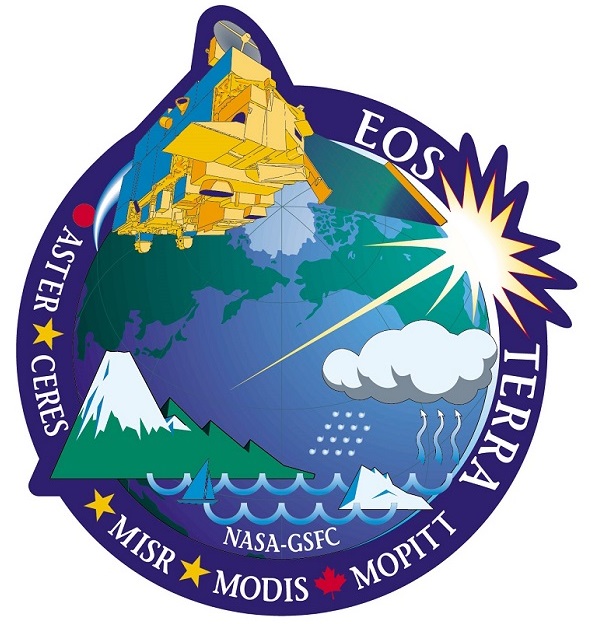Terra: the EOS Flagship


Terra: The EOS Flagship
Terra explores the connections between Earth’s atmosphere, land, snow and ice, ocean, and energy balance to understand Earth’s climate and climate change and to map the impact of human activity and natural disasters on communities and ecosystems
Connecting Earth’s Systems with Terra’s Observations
Examples of each instrument’s capabilities (clockwise): land composition (ASTER), reflected energy (CERES), aerosols (MISR), vegetation snow and ice (MODIS), carbon monoxide (MOPITT)
Important Terra Updates and Information
Terra has not been transmitting Direct Broadcast since May 11, 2024, due to a solar array power generation issue limiting our ability to continue all science and provide Direct Broadcast continuously. Unfortunately, there are no plans to resume Terra Direct Broadcast.
Terra successfully completed a multi-day special maneuver to allow for calibration of the MODIS instrument’s diffuser. Data collection from all Terra instruments were briefly interrupted during this process (see specific dates and times below).
Day 1 (11/12/24) – 16:41z – 22:22z
Day 2 (11/13/24) – 12:24z – 21:25z
Day 3 (11/14/24) – 13:01z – 22:04z
Day 4 (11/15/24) – 12:07z – 20:38z
The Terra and Aqua Flight Operation Team (FOT) transitioned fully to Light-Out-Operations (LOOps) on July 7th 2023 at 6am EDT, following successful testing and Ops Readiness Review.
In the LOOps configuration there will not be an on-console engineer working the 12-hour night shift (6pm-6am), but instead system support engineers will be on call during lights out period to respond to red limit alarms as needed.
FOT will no longer attempt to fill science data gaps via Solid State Recorder replays so additional data losses and larger data gaps are expected, though estimated data capture is expected to remain above mission data capture guideline of 95%.
For more information and a list of known Terra and Aqua data gaps due to LOOps, visit this informational page located on the MODIS Adaptive Processing System (MODAPS) website.


Terra data users have expressed the need for weekly updates on Terra’s equator crossing time (in Mean Local Time), as well as orbital altitude. Starting this month, we’ll be adding this information to the Terra homepage and updating it weekly using data provided by the Operations Team. Move your cursor over the chart below to view both Terra’s Mean Local Equator Crossing Time in UTC and orbital altitude for each month through 2026.
Update on Terra’s New Orbit: Since 2020, Terra has been drifting to an earlier equator crossing time, and in October 2022 was lowered by ~5km in altitude. These changes in orbit did not reduce the data quality of Terra products, and only created minor changes to orbital repeat time and swath width (for some instruments). See Terra’s New Orbit for more information.

9:37 AM (Mean Local Time)

695 KM
(Updated November 2024)

Click the links below to catch up on all the latest Terra news and updates!
Past News Features
- Terra 2024 Thanksgiving Greetings!This year has been a busy one for Terra, with our 25th Anniversary just around the corner! (Learn more and RSVP here!) In the season of thanksgiving, Terra is especially grateful for the following: Thanks again for all of your support over the years! Wishing you all a relaxing holiday full of food and friends!
- Terra Views the Eclipse! (April 8)You may have heard about the upcoming full solar eclipse, happening this upcoming April 8th, 2024 — but did you know Terra will have one of the “best seats in the house” for viewing this rare celestial experience?! In the United States, the center “totality” shadow of the eclipse will pass from south to north …
- Top 2023 Terra & Earth Observatory StoriesBefore we kick off an exciting year — full of celebrating Terra’s upcoming 25th Anniversary! — let’s take a moment to look back at the top-viewed monthly Earth Observatory stories featuring the Terra mission from 2023! Click the linked month in each banner to jump down to a brief article summary and image thumbnail. Want …
Terra’s Lower Orbit Virtual Community Forum
NASA’s Terra, Aqua, and Aura Drifting Orbits Workshop Information
Terra Begins Drifting. What’s Next?
After more than 20 years orbiting at 705 km above Earth’s surface and routinely crossing the equator at approximately the same time every day, Terra is now drifting. With no maneuvers planned to sustain Terra’s altitude and crossing time, Terra will slowly get closer and closer to Earth – crossing the equator earlier and earlier as time passes. However, despite impacts to some of Terra’s nearly 100 data products, Terra’s five sensors continue to collect meaningful scientific data, producing one of the longest continuous climate data records collected by a satellite. Read more…
Terra: Providing Critical Data to Help Society
Twenty Years of Terra in Our Lives
There is no question that technology has changed. But, at the same time that our lives on Earth were being shaped by our access to technology, 705 kilometers above us, a satellite was changing how we understood our planet.
For 20 years, Terra, the flagship Earth observing satellite,
has chronicled changes on Earth. Designed and built in the 1980s and 90s, NASA and Lockheed Martin engineers set out to build a satellite that could take simultaneous measurements of Earth’s atmosphere, land, and water. Its mission – to understand how Earth is changing and to identify the consequences for life on Earth. Season after season, Terra data continues to help
us understand how the evolving systems of our planet affect our lives – and how
we can use that data to benefit society. Read more and find resources from our anniversary events, Terra 20 Events
Update on Terra’s New Orbit: Since 2020, Terra has been drifting to an earlier equator crossing time, and in October 2022 was lowered by ~5km in altitude. These changes in orbit did not reduce the data quality of Terra products, and only created minor changes to orbital repeat time and swath width (for some instruments). See Terra’s New Orbit for more information.










